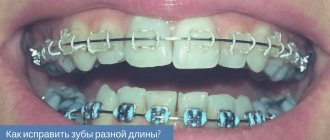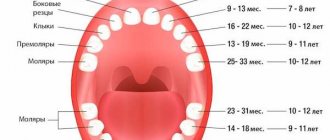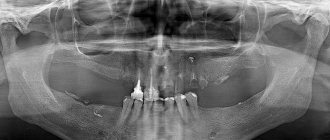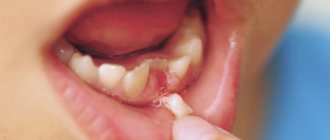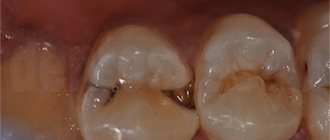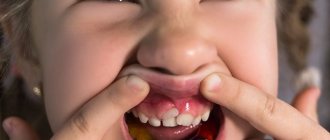04.08.2016
baby shower
Summer holidays are a joy for children and a hassle for parents. Kids spend a lot of time outside, frolicking in the yard, and sometimes games can lead to injuries. One of the common reasons for visiting a pediatric dentist is dental injuries.
But we hasten to reassure you, there is no need to panic - the tooth can be saved. The main thing is to take the right measures in the first half hour and immediately consult a doctor.
Baby tooth injury
If a child knocks out a baby tooth, don’t worry: a new one will grow in its place. Let your mouth rinse with a disinfectant. But it won’t be superfluous to show your baby to the doctor, don’t hesitate.
If you are interested in the question: “Is it possible to put a knocked-out tooth back?”, then we answered this question in more detail below.
What to do first
Regardless of the child’s well-being and the complexity of the injury, it is imperative to consult a doctor - to the emergency room, the nearest dental clinic, and if the physical condition of the victim is of concern and he cannot move independently, then you can call a doctor at home. Before examining a specialist, you need to calm the baby down and, if necessary, give an anesthetic. Further actions will depend on the nature of the damage.
When bleeding
If blood is flowing from a wound, it is not recommended to stop it for the first couple of minutes - pathogenic microorganisms that may have entered the hole due to damage will come out along with it. If bleeding continues, you should roll up a small piece of sterile bandage or gauze into a tampon, place it on the wound, and ask the child to clench his jaw.
It is important to know! When bleeding comes from a wound, you should not give your child acetylsalicylic acid, anti-inflammatory drugs, or others that thin the blood. Such “treatment” can result in blood loss.
If some time has already passed after the injury, and a blood clot has formed at the site of the defect, under no circumstances should you use rinses or apply a tampon. The resulting clot serves to protect the damaged area from pathogenic microorganisms.
Loss of a permanent tooth
If a child’s permanent tooth, front or molar, is knocked out, it doesn’t matter, it can be restored if it is quickly preserved. The found unit of the dentition should be immediately placed in a saline solution or in a solution intended for storing lenses. It is in this form that the tooth should be brought to the doctor within half an hour after it falls out. According to statistics, the survival rate in this situation can be about 90%. It is not recommended to rinse with water or place the tooth in water, or try to insert it into place yourself.
If a unit is partially knocked out and hangs on the gum, you can correct the tooth by carefully returning it to its original position. To fix it, you need to bite on a clean handkerchief or a piece of bandage. And immediately contact your dentist or emergency room.
If the milk unit is knocked out
If a baby tooth is knocked out, it can also be saved. By the way, not every clinic will have a doctor perform replantation of a mammary unit, especially for a one-year-old child who will not allow this procedure to be performed. In addition, it makes no sense to restore the loss if there is an active change in the bite - in order to make sure that the tooth was “ready” to leave the oral cavity, the dentist will prescribe an x-ray.
Fracture of the upper part of the tooth (crown)
Another common case in practice is crown fracture. In such a circumstance you need:
- Treat the mucous membrane at the fracture site with an oral disinfectant solution.
- To avoid swelling, apply a cold compress to the injury site.
- If a sharp edge forms, cover it (put some cotton wool) so as not to damage the lip and tongue.
- Seek medical help.
These simple steps must be performed quickly. See a doctor urgently!
In what cases should you consult a doctor?
Unfortunately, when a tooth is knocked out, especially in the absence of bleeding, people rarely go to the dentist. However, parents need to be vigilant and pay attention not only to the absence of a unit in the dentition, but also to other symptoms that indicate infection has penetrated into the wound and the development of complications. These signs include the following:
- increasing pain at the site of the defect,
- redness and swelling of the gums around the wound,
- purulent discharge from the damaged area,
- temperature increase: even slight,
- the tooth is intact, but is loose or spinning in the socket,
- if the unit is intact, visually it looks pressed into the hole.
“As a rule, if a baby tooth is knocked out, it is lost completely, from the root. Temporary units are not so firmly fixed in the holes, and a slight blow is enough to lose them. In the case of permanent ones, a fracture occurs more often - their roots are stronger and go deeper into the bone, so it is more difficult to knock them out,” says expert, dental therapist Oksana Vladimirovna Titova.
Tooth luxation
Dental surgeons also often encounter tooth dislocation in children (the tooth begins to become loose). Also, with such an injury, the baby tooth can completely enter the gum. In any case, it is necessary to consult a doctor as soon as possible and take an x-ray, which will show the condition of the affected tooth. After receiving the result, the dentist will make a decision: remove the tooth or leave it as is until a permanent one appears. How to prepare a child for a visit to the dentist is an equally important question. And you can easily find the answer to it on our blog.
Pediatric dentistry at the PRISMA clinic wishes you and your children healthy teeth!
Tell your friends: Twitter Facebook Google
What consequences may there be
A piece of teeth knocked out in childhood can lead to the following complications:
- malocclusion: neighboring teeth will shift, preventing the formation of permanent teeth,
- speech defects: their risk especially increases with the loss of incisors, which take an active part in articulation,
- diseases of the digestive tract: the inability to thoroughly chew food leads to its insufficient processing by oral enzymes, swallowing in pieces, which over time provokes gastrointestinal diseases.
Also among the negative consequences can be noted: violation of the aesthetics of the dentition, the appearance of problems in communicating with peers, an increased risk of pathologies in neighboring units, frequent inflammation even after successful treatment.
Act quickly. The tooth can be saved
An injured tooth can be brought back to life if treated as soon as possible.
The work of a pediatric dentist at Idealdent is aerobatics:
- will restore a broken or dislocated tooth;
- splints the mobile group;
- will preserve the nerve so that the damaged dental unit grows and performs functionality.
View prices for pediatric dentistry
How to restore a knocked out tooth
When contacting a dentist, first of all, he will perform an antiseptic treatment of the wound and prescribe an x-ray. Subsequent actions will depend on the nature of the damage.
So, if a tooth is completely knocked out, the doctor can insert it (provided it is intact) in the near future into the hole, ensuring fixation with a splint; if necessary, stitches are placed on the wound. On average, engraftment lasts about two months, during which you will need to regularly visit a specialist. In the future, observation by an orthodontist will be required.
If the tooth “hangs” on the gum, after anesthesia, the doctor carries out appropriate treatment. This could be: suturing a wound, filling canals, fixing a broken part of a crown, and so on depending on the situation. All actions are carried out on the basis of radiographic data.
“When my son broke his upper incisor, the dentist re-seated part of the crown with some kind of compound. For two years we protected this incisor, followed a soft diet and so on. Now it has fallen out safely, and the new one is growing without problems...”
Elizaveta O. (from a message on the woman.ru forum)
IF A CHILD KNOWS OUT A MILK TOOTH
- Due to the small age of the child, additional technical difficulties immediately arise, therefore, the knocked out tooth, if it has fallen out, should be placed immediately in cow’s milk.
- You need to get to the dentist within 30 minutes.
- There is a possibility that the dentist will refuse to replant a baby tooth, citing the patient’s young age and a change of teeth in the near future, that is, the inappropriateness of the procedure. But baby teeth are also subject to replantation, remember this. If you're lucky, the dentist will turn out to be sane and believes in miracles, and the tooth will be a vigorous, lively person; the child will implant the tooth. Need to try.
The dentist will do additional fixation, prescribe physical procedures, the tooth will take root - that’s elementary.
Symptoms
To suspect that a child has broken a front tooth is quite simple:
- Violation of the shape and integrity of the dental crown. Upon examination, you may notice a chipped tooth and a defect;
- Appearance of a crack. Characteristic of an incomplete fracture, part of the tooth may wobble, but not break off;
- Strong pain. The pain can be localized in the tooth, gum, or even spread to the entire jaw, depending on the severity and nature of the injury. Pain in the jaw occurs with impacted fractures, which are most often the result of trauma. Young children who cannot say what happened begin to cry and refuse food;
- Swelling, redness, bleeding of the gums. In some cases, the fracture is also accompanied by injuries to the soft tissues of the oral cavity. In severe cases, pathological mobility of adjacent teeth may appear.
First aid supplies
If a child has a knocked out tooth due to injury, it is important to provide first aid correctly. To begin, ask your child to rinse his mouth with clean boiled water cooled to body temperature. If the child is small and does not yet know how to do this, ask him to take water into his mouth several times and spit it out.
Important: if by the time you discover the injury, only a hole filled with a blood clot remains in place of the tooth, you should under no circumstances rinse your mouth. This clot acts as a “plug”, which prevents bleeding and protects the socket from the penetration of microbes and the ingress of soft plaque and food particles into it.
If a child has bleeding from the gums at the site of a knocked out tooth and/or the gums are severely damaged, the first aid algorithm consists of the following sequence of actions:
- In the first few minutes after the injury, do not try to stop the bleeding - the blood flow washes out bacteria and foreign particles that entered it during the injury from the hole.
- If the bleeding does not stop within 5-10 minutes, roll up a tight swab of sterile gauze, place it on the site of the knocked out tooth and ask the child to clench his jaw to hold the swab in place. When rolling up the tampon, make sure that the edges of the napkin are folded inward and that there are no threads sticking out of the tampon. Keep young children in sight to prevent the tampon from getting stuck in their throat.
- If a child complains of severe pain, he can be given Efferalgan, Panadol, Paracetamol or another drug that he usually takes for a sore throat, ARVI and colds. Never give your child NSAIDs, including aspirin or aspirin-containing medications, without consulting a doctor - they reduce blood clotting and can cause bleeding.
If any signs of a tooth fracture are detected in a child, it is necessary to promptly visit a pediatric dentist.
How are they treated?
The dentist determines treatment tactics depending on the severity of the injury and the condition of the tooth. The following methods are used:
- Tooth restoration. Suitable only in cases where a small piece of the tooth has broken off and the pulp is not involved in the pathological process. Various types of composite materials are used to restore the integrity and normal appearance of the tooth;
- Depulpation. This procedure is used for more severe fractures when the child has symptoms of pulpitis. The process removes the infected pulp, which allows you to save the tooth and prevent the child from developing a malocclusion;
- Delete. A radical measure that is used in cases where it is no longer possible to save the tooth.
How to restore a damaged area?
A child with a chipped tooth should be taken to the dentist immediately. The doctor will fill the canals in the exposed pulp and remove the nerve bundle. In general, different methods and technologies are used today to restore and preserve teeth.
- For a broken tooth, dental crowns are used.
- The doctor can place veneers for children.
- When a tooth is broken or chipped, your doctor may place baby inlays.
The use of a crown is advisable when a tooth in the upper row of incisors is broken or when the chewing teeth are damaged. But at the same time, processing (grinding) is carried out on neighboring ones.
You can restore your front teeth thanks to thin onlays - veneers, which can be matched to the rest of your teeth. If a tooth is broken and cannot be restored, the doctor will clean the canals and install an inlay (implant).
With the help of intracanal pins, it is possible to restore a chipped tooth if the parents decided to save it. With this method of dentures, aesthetics are preserved as much as possible. The operation will not affect the bite or chewing function.
What are the dangers of dental injuries?
Tooth decay is associated with damage to internal tissues. If caries is not treated in time, damage to the pulp - the core of the tooth with the presence of nerves and blood vessels - will occur. And then – the inflammatory process. The child will begin to feel constant toothache and complain about his health. The inflammatory process will affect different areas. In children, pulp periodontitis develops due to inflammation. This is due to the fact that the roots of a child’s tooth develop and strengthen over a long period of time, so damage occurs faster.
Prevention of childhood dental injuries
In order not to encounter the situations described above, you should take care in advance of the safety of the baby’s oral cavity. Remember that some dental injuries can be prevented by using simple protective measures:
- An excellent protection against injury during active games or sports is a helmet that not only protects the head, but also the teeth.
- To protect your child's teeth, use a mouthguard. This simple dental product provides as much as 85% protection.
- Talk to your children about the importance of being careful when playing. But don't intimidate them.
- Teach your child to fall without injury. Demonstrate how to tuck to avoid head and neck injuries.
- Provide your baby with healthy nutrition with all the necessary vitamins and microelements.
- Teach your child to brush their teeth regularly and visit the dentist every six months.
If you still failed to protect your baby from injury, you should contact your dentist as soon as possible. You can get qualified help at Aesculapius dentistry. In our dentistry you will find first-class equipment and modern treatment methods.
Four specialists work in one shift and they know their job very well. We work with each patient on an individual basis and provide a guarantee for all services. Absolutely all clients are satisfied with the level of service.
Possible complications
Complex injuries can often have serious consequences, manifested in complications. It doesn’t matter which tooth was injured – the front incisor, the chewing tooth. After the examination, the doctor will decide how to save the child’s tooth. If you neglect the recommendations of a specialist, this can lead to more serious consequences, not to mention aesthetics.
Types of complications
1. Possibility of infection of the pulp area.
2. Increased tooth sensitivity.
3. The appearance of a bend in the tooth root.
4. Violation of occlusion.
5. Formation of cysts and granulomas.
You need to prepare for the fact that a damaged child’s tooth will begin to change the angle of development. And this leads to deformation not only of the damaged tooth, but also of its healthy neighbors. If it is necessary to remove a broken tooth, the space must be filled with an implant. If filling is not carried out, other teeth will begin to shift and move closer together, which leads to occlusion disorders - bite.
Where to put the knocked out tooth?
Make sure that the tooth does not dry out and call the clinic. Take the crown part without touching the roots, rinse in cold water. Do not use alcohol, antiseptics, hydrogen peroxide, or mechanically clean dirt.
Suitable for transportation:
- A container for lenses and the saline solution in it.
- A container with milk or a pharmaceutical preparation - glucose, 0.02% furatsilin, novocaine, sodium chloride.
- The victim's own saliva, if nothing is available.

